 Yes, as I have said before, doggies just love our dust sheets, whether it is lying on them, sniffing them or playing with them, they just can’t resist our dustsheets. If there is a dog or dogs in the house no sooner have we laid out the sheets they will appear, sniffing them, sitting on them or laying on them. Clearly, we have laid out the sheets just for them and for no other purpose. This Boarder Terrier is a little girl called Indie, she is ever so friendly and loves playing with her little rubber ball. Although we found out that she doesn’t like going outside when it is cold!! Just like the day we visited!!
Yes, as I have said before, doggies just love our dust sheets, whether it is lying on them, sniffing them or playing with them, they just can’t resist our dustsheets. If there is a dog or dogs in the house no sooner have we laid out the sheets they will appear, sniffing them, sitting on them or laying on them. Clearly, we have laid out the sheets just for them and for no other purpose. This Boarder Terrier is a little girl called Indie, she is ever so friendly and loves playing with her little rubber ball. Although we found out that she doesn’t like going outside when it is cold!! Just like the day we visited!!
Doggie Helper – Indie Sewards End
Great Sampford – Jydepejsen Avanti Wood-Burning Stove
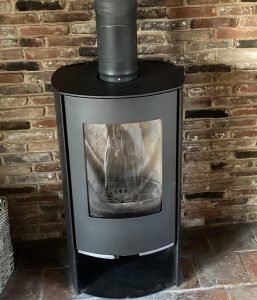
I am starting to come across a small number of these Jydepejsen Wood-Burning Stove, this example is an Jydepejsen Avanti Wood-Burning Stove. I swept another example of this very same stove on a factory made chimney in Wethersfiels just the other day. It looks like one of the local installers has started fitting them, but I don’t know who the installer is. They make a wide range of stoves, their stove models include; Bella, Cosmo, Country, Cozy, Cubic, Elegance, Mido, Omega, Orion, Panorama, Senza, Troja and Zeta. Looking at their website, it would appear that the Avanti model is no longer in production, even though it has a very modern contemporary look and is a very stylish efficient stove. Having said this the whole of the Jydepejsen range of stoves looks ultra contemporary and very stylish as well as being very ecofriendly and efficient.
Jydepejsen are based in Denmarl and have been manufacturing stoves since 1979. There company blurb reads as follows: Jydepejsen A/S has created innovative and exceptional Danish wood-burning stoves for more than 40 years. Jydepejsen is 100% Danish and our wood-burning stoves are designed by recognised Danish architects and furniture designers who create products that are out of the ordinary. Our wood-burning stoves have a stylish design focusing on easy operation and environment friendliness.
Jydepejsen A/S
Ahornsvinget 3-7,
Near Felding
DK-7500 Holstebro
Denmark
T +45 96101200
info@jydepejsen.dk
https://www.jydepejsen.com/en/meet-our-designers
Guild of Master Sweeps 5 Year Refresher Course
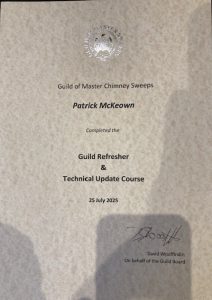 I recently completed the Guild of Master Chimney Sweeps 5 Year Refresher & Technical Update Course, here is the certificate I received. I just can’t believe that I have now been working in the sweeping industry for over 10 years now! It was a day long course completed online and there were 6 other sweeps undertaking the course along with myself. The course was run by the excellent Gavin Cator (Bryan Cator Ltd – Thetford Norfolk) who has significant sweeping experience and extensive knowledge. The course was packed with lots of interesting material and updates as a lot has changed in the ten years since I undertook the chimney sweeping training course with the guild. It was mentioned that the Guild might begin an on going system of professional development, negating the need for five year refresher courses.
I recently completed the Guild of Master Chimney Sweeps 5 Year Refresher & Technical Update Course, here is the certificate I received. I just can’t believe that I have now been working in the sweeping industry for over 10 years now! It was a day long course completed online and there were 6 other sweeps undertaking the course along with myself. The course was run by the excellent Gavin Cator (Bryan Cator Ltd – Thetford Norfolk) who has significant sweeping experience and extensive knowledge. The course was packed with lots of interesting material and updates as a lot has changed in the ten years since I undertook the chimney sweeping training course with the guild. It was mentioned that the Guild might begin an on going system of professional development, negating the need for five year refresher courses.
Sweeping for the Bishop of Chelmsford Again – Finchingfield Church
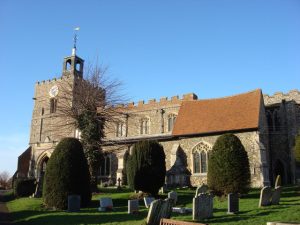
Yes, here we are sweeping for the Bishop of Chelmsford again, and on this occasion, it was the vicarage in the beautiful village of Finchingfield. Indeed, many people describe Finchingfield as the most beautiful or picturesque village in England. Perhaps that is an arguable point, but it is certainly busy with tourists and day trippers throughout the year. In my view there is something quintessentially English about Finchingfield, like a village out of an Agatha Christie novel. We have swept the vicarage chimney on a number of occasions now and are quite familiar with it. To be honest it is a really quick job, a modern property, with an open fire with a modern lined chimney that is swept regularly (by me), and that only has occasional use. Like a number of the vicarages we sweep, the actual vicarage is situated a little distance from the church, in this instance it is down the hill on which the church sits, across the green, on the other side of the pond.
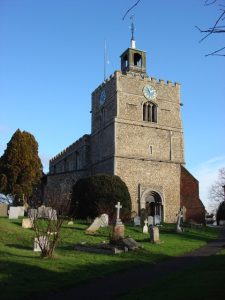
The medieval church of St John the Baptist sits in a prominent position on top of a hill and behind the medieval Guild Hall. The church fabric dates largely from the Norman period. The church consists of a chancel with two-bay N and S chapels, a nave with a clerestory and 5-bay aisles, a 12thc tower and a S porch. The earliest part is the W tower, of c.1170. The chancel was rebuilt in the mid-13thc , and the N chapel arcade and S nave arcade date from this period too. The N nave arcade, with clustered piers, is slightly later. The S chapel arcade is 15thc, as is the W bay of the N arcade. In the 15thc the bell-chamber of the tower was altered or rebuilt; a spire was built possibly at the same time, but it fell in the 17thc and a cupola with an open bell stage was added in the 18thc. The church was restored in the 1865-66 by Henry Stock, and the S porch rebuilt. The only Romanesque features are in the tower, and include the W doorway, the tower arch, with rich but badly eroded and enigmatic decoration on the jambs, and deep 3-bay arcading at the two interior E angles. 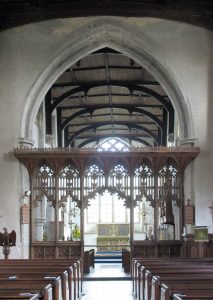
Valentine Gray – The Sad story of another Victorian Climbing Boy
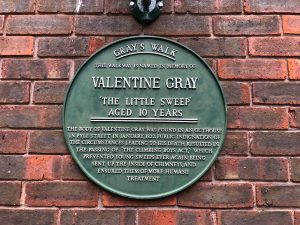 Here is another sad story of a Victorian chimney sweeps apprentice or climbing boy. You might remember that The Guild of Master Sweeps recently played a part in memorialising the death of George Brewster who died trapped in a chimney at Fulbourn County Pauper and Lunatic Asylum in February 1875.
Here is another sad story of a Victorian chimney sweeps apprentice or climbing boy. You might remember that The Guild of Master Sweeps recently played a part in memorialising the death of George Brewster who died trapped in a chimney at Fulbourn County Pauper and Lunatic Asylum in February 1875.
John Valentine Gray was apprenticed to chimney sweep Benjamin Davies in Newport but in 1822, at the age of only ten, he died at the hands of his master, who was later convicted of manslaughter. He did not die in a chimney but there is no doubt that his unhealthy lifestyle and the inhumane treatment received from his employer contributed to his early death.
In 1822 a nine-year-old boy, Valentine Gray, who was one of the many chimney climbing boys, was found dead in the filthy outhouse pertaining to a public house of ill-repute known as The Rum Puncheon (no longer standing). He had been forced to sleep in one of the numerous slum alleys radiating off Pyle Street in Newport, Isle of Wight. His body was undernourished and emaciated. A medical examination showed that his body was covered with bruises and at his inquest, his death was reported as due to ‘a severe blow or blows to the head’ – the verdict was “Manslaughter against Davis (his master) and his wife.” Benjamin and Margaret Davis stood trial at the Lent Assizes 1822 at Winchester Crown Court – Davis was found guilty and sentenced to one year’s imprisonment; his wife was acquitted. Davis was imprisoned for the offence but strangely, only until he had paid a fine of one shilling.

Valentine had been born into a poor family in Alverstoke in Hampshire and Benjamin Davis had taken him out of the Poor House there in October 1821 to be an apprentice Sweep. Valentine had lived in the workhouse from lived from 6 months of age after the death of his mother. Public concern about the use of children as sweep’s apprentices had been aroused years earlier by Jonas Hanway, London philanthropist. National publicity about Valentine Gray’s death added weight to the campaign which led eventually to the Climbing Boys Act of 1834. This was hardly a watershed for it merely specified that no children under ten were to be so employed. Further Acts were passed by parliament but not until 1840 were there regulations forbidding use of chimney sweeps under the age of twenty one. Even this act was not really effective as employers ignored it, finding it inconvenient to function without small climbers. Eventually police were given powers to prosecute and in 1875 the tribulations of Valentine Gray’s successors were at last at an end.
On the Island, compassion, (or possibly a sense of guilt and shame), led to a public subscription being organised by John Matthews of Pyle Street for the erection of a memorial in the burial ground of the parish church of St Thomas’, Newport. You might think, given the brutality of the crime, that Davis was made an example of but despite being found guilty of manslaughter his sentence was a one-shilling fine (5p in today’s money) and this sparked public outrage.

Jotul F118 Black Bear Wood-Burning Stove – Elmdon

I recently swept the flue to this original Jotul F118 Wood-Burning Stove at an address in Elmdon. The customer told me that they had owned the stove for over 30 years and that it originally came from another property where it had been in service for a number of years. As you can see from the photo, it’s a rather unusual, quirky, but strangely attractive stove. I should imagine that it looks rather beautiful when it is a light and burning! It is also a deceptive stove, having as it does a long and rather capacious fire-box. The customer reports that it certainly throws out the heat in the winter!
Jotul are a Norweigan company and have been making stoves and fireplaces for over 160 years. Jotul are proud of their global status, selling their products in 43 different countries spread over six continents – Truly a global brand!
Jøtul was founded by Oluf Onsum as Kværner Jernstøberi (Kværner Foundry) in the outskirts of Christiania (now Oslo) in 1853. While stoves initially were the main products, the company had diversified by the beginning of the 20th century, when it produced turbines and lumber equipment.
As the heating appliance manufacture decreased in importance, the production was spun off in 1916 and sold to Herman Anker, one of Kværner’s managers. He founded Jøtul AS in 1920 as a sales organization for its products. The sales stagnated during the depression in the 1920s, and 36-year-old Herman Anker died in 1927, leaving it to his successor, 34-year-old Johannes Gahr to modernize and eventually salvage the company. By 1935, the turnaround had succeeded, and the firm acquired its modern name.
By the 1960s, stoves using liquid fuels, especially kerosene had supplanted wood-burning appliances, a trend that was only reversed in the 1970s, partly due to the 1973 oil crisis. Jøtul used this opportunity to gain a strong international foothold and drastically increased its exports to continental Europe and North America.
The Gahr family sold the business to Norcem in 1977, and a period of international expansion began, as Jøtul acquired a number of foundries and importers abroad. This period lasted for approximately ten years, but came to an end during the recession in the late 1980s, when Jøtul once again focussed on the domestic market. However, it has resumed its international diversification in the 21st century, and today its products are sold worldwide.
In March 2018, Jøtul was acquired by the global private equity firm OpenGate Capital. Along with management, OpenGate has crafted a plan to boost performance and eliminate inefficiencies in Jøtul’s operations. In addition, OpenGate Capital is actively searching for add-on targets to further drive Jøtul’s growth. In November 2018, OpenGate and Jøtul completed the add-on acquisition of AICO, an Italian and French based pellet-burning stove leader.
St Florian – Patron Saint of Chimney Sweeps
 Only the other day I was reading a very interesting book, ‘Sapiens’ by Yuval Noah Harari. Subtitled ‘A brief history of humankind’, it details all you need to know about the history of people and human activity – Fascinating stuff! It was while I was reading the chapter about religion that the author mentioned Patron Saints, noting that the Patron Saint of Chimney Sweeps was St Florian. This got me intrigued, I didn’t even know that chimney sweeps had a patron saint, and I had never heard of St Florian. I therefore did a quick internet search and this is what I found.
Only the other day I was reading a very interesting book, ‘Sapiens’ by Yuval Noah Harari. Subtitled ‘A brief history of humankind’, it details all you need to know about the history of people and human activity – Fascinating stuff! It was while I was reading the chapter about religion that the author mentioned Patron Saints, noting that the Patron Saint of Chimney Sweeps was St Florian. This got me intrigued, I didn’t even know that chimney sweeps had a patron saint, and I had never heard of St Florian. I therefore did a quick internet search and this is what I found.
Florian (Latin: Florianus; AD 250 – c. 304) was a Christian holy man and the patron saint of chimney sweeps, soapmakers, and firefighters. His feast day is 4 May. Florian is also the patron saint of Poland; the city of Linz, Austria; and Upper Austria, jointly with Leopold III, Margrave of Austria.
Florian was born around AD 250 in the ancient Roman city of Aelium Cetium, present-day Sankt Pölten, Austria. He joined the Roman Army and advanced in the ranks, rising to commander of the imperial army in the Roman province of Noricum. In addition to his military duties, he was also responsible for organizing and leading firefighting brigades. Florian organized and trained an elite group of soldiers whose sole duty was to fight fires.
During the Diocletianic Persecution of Christians, reports reached Rome that Florian was not enforcing the proscriptions against Christians in his territory. Aquilinus was sent to investigate these reports. When Aquilinus ordered Florian to offer sacrifice to the Roman gods in accordance with Roman religion, Florian refused. Florian was sentenced to be burned at the stake. Standing on the funeral pyre, Florian is reputed to have challenged the Roman soldiers to light the fire, saying “If you wish to know that I am not afraid of your torture, light the fire, and in the name of the Lord I will climb onto it.” Apprehensive of his words, the soldiers did not burn Florian, but executed him by drowning him in the Enns River with a millstone tied around his neck instead.[3][4]
His body was later retrieved by Christians and buried at an Augustinian monastery near Lorch. Later a woman named Valeria had a vision in which she saw him; Florian, in this vision, declared his intent to be buried in a more appropriate location.
Florian is very widely venerated in Central Europe. His feast day is 4 May. The Austrian town of Sankt Florian is named after him. According to legend, his body was interred at St. Florian Monastery, around which the town grew up. Florian was adopted as patron saint of Poland in 1184, when Pope Lucius III consented to the request of Prince Casimir II to send relics of Florian to that country. Kraków thus claims some of his relics.
A statue of Florian by Josef Josephu was unveiled in Vienna in 1935. It stood at the main firehouse of Vienna, in the city’s main square, Am Hof. After the firehouse was bombed in 1945 during World War II the statue was moved on to the Fire Brigade Museum (Wiener Feuerwehrmuseum). Seeking the sponsorship of a helpful saint was and still is a part of the name-giving practice in Catholic areas. In the southern, Catholic, parts of the German Empire (mainly present Bavaria and Austria), peasants regularly have used the name, Florian, as one of the given names for at least one of their male children: to secure the saint’s patronage against fire. Hence the given name is still widespread in these areas.
St Florian was also celebrated in Hungary. Two statues honoring Saints Vendel and Florian can be found in a small square in Zalavár, despite the village situates outside historically German-speaking regions.
Sewards End – Rais Viva L100 Wood-Burning Stove
 Up until relatively recently I had not come across any examples of these Rais stoves, but I am now beginning to see more and more of them. This attractive contemporary cylindrical model is the Rais Viva L100 Wood-Burning Stove. They are as you can see very stylish and well put together. They are also relatively easy to work on which is good for the chimney sweep. I think that they are very stylish and contemporary in their looks. Rais stoves can only be bought from authorized UK dealerships.
Up until relatively recently I had not come across any examples of these Rais stoves, but I am now beginning to see more and more of them. This attractive contemporary cylindrical model is the Rais Viva L100 Wood-Burning Stove. They are as you can see very stylish and well put together. They are also relatively easy to work on which is good for the chimney sweep. I think that they are very stylish and contemporary in their looks. Rais stoves can only be bought from authorized UK dealerships.
Rais are a Danish company who export 90% of their stoves to other countries in Western Europe and the United States. The Rias factory is located at Frederikshavn in Danemark and employs over 80 people in the production of stoves and each with their own personal responsibility. Their marketing stresses that if you buy a Rais stove “you get Danish design that never compromises on quality, we call it the art of the fire”. They have a large range of different stove models, including: the Caro 90, 110 and Caro SST, the Viva L 100, 120, 140 and 160, the Nexo 100, 120, 140 and 160, & 185, Max 600, the Pilar, the Juno L 120 & 160, the Q-Tee, Q-Tee 2 & Q-Tee C, The Bionic and the Q-Be & Q-Be XL.
Thatched Fighting Kangaroos on a West Wickham Roof

Here’s another animal you don’t often see in Britain, but I suppose it comes as no surprise to find them on rooves in the UK as many Australians call this country home. This pair seem to be having a right set too about something. I wonder which one is going to come out on top.
In addition to their females’ pouches, kangaroos are known for their “boxing” skills, and here’s the reason why: Male kangaroos often fight to establish dominance or win a mate. Fights consist mostly of balancing on their tails while trying to knock their opponent off balance.
We will keep a lookout for more thatched animals whilst we are on our travels, they are always good fun to see! We tend to notice them as we have the chimney sweeps habit of always looking at chimneys. Standby for further amusing sweeps from the Walden Sweeps team.
Bassingbourne – Town & Country Pickering Wood-Burning Stove

I do sweep a lot of these Town and Country stoves, this example which I recently swept in Bassingbourne is the Town & Country Pickering Wood-Burning Stove. The most common models that I come across being the Little Thurlow, the Bransdale and the Thornton Dale. I don’t think they are the chimney sweeps favorite stove to sweep, as they have to be largely dismantled to access the flue. This is not so bad, but if the vermiculite bricks are cracked, as they frequently are, the stove is difficult to reassemble. This said, all the customers who I sweep for who have Town & Country stoves swear by them for their fuel efficiency and heat output. In fact, I have not come across a customer who has a Town & Country stove who is displeased with their performance. Well each to there own!!!
Town and Country Fires is a family run business based in Pickering on the edge of the North Yorkshire Moors. Once farmers, the Thurlow family took the big decision to diversify and as a consequence started the stove business in 1977.
Gaining a wealth of experience over the years and using a combination of old and new techniques has led to the company developing and manufacturing some of the best, energy efficient, solid fuel and wood burning stoves in the world.
Town & Country stoves
1 Enterprise Way
Thornton Road Industrial Estate,
Pickering, North Yorkshire. YO18 7NA
Telephone: 01751 474 803
Fax: 01751 475 205


 My name is Paddy McKeown, I am a retired police officer (Detective Sergeant – Metropolitan Police), turned chimney sweep. I have completed training with ‘The Guild of Master Chimney Sweeps’, and Rod Tech UK (Power Sweeping).
My name is Paddy McKeown, I am a retired police officer (Detective Sergeant – Metropolitan Police), turned chimney sweep. I have completed training with ‘The Guild of Master Chimney Sweeps’, and Rod Tech UK (Power Sweeping).



